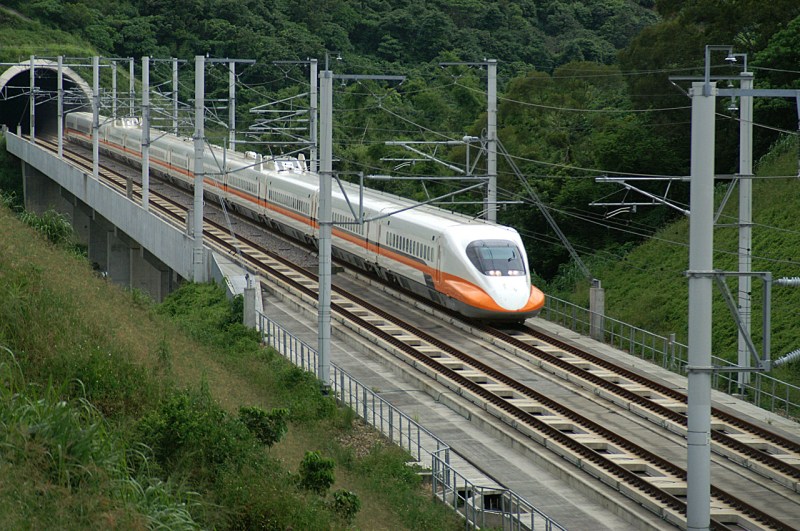Expert: Colorado Should Build High-Speed Rail Along I-25
As the state studies rail options along the congested I-25 corridor, an expert says few would ride options slower than high-speed rail. But a well-funded anti-rail cabal is likely to defeat any push for bullet trains.

Better walking. Better biking. Better transit. Support the nonprofit mission of Streetsblog Denver now. Give $10 per month.
As the state projects a 35 percent increase in population along the Front Range by 2045 and transportation officials realize they can’t just widen roads to solve traffic congestion, Colorado announced last week that it will again study building a rail line along Interstate 25 from Pueblo to Fort Collins. But an expert on high-speed rail said the state should favor bullet trains in its plans — which will face well-organized opposition — instead of pushing for less expensive options.
“Why bother doing anything if we’re just going do some slow rail system that few people are going to ride?” asked Andy Kunz, CEO of the U.S. High Speed Rail Association. “That’s a waste of time and money.”
When the study is completed, Colorado officials may pitch voters on building a slower, less expensive rail system, according to Randy Grauberger, project director Southwest Chief & Front Range Passenger Rail Commission and David Krutsinger, transit and rail director of CDOT. They say options cheaper than high-speed rail are likely to be recommended after the Trump administration erased potential federal funds for bullet trains and Colorado voters rejected two transportation funding measures last November.
Their political calculations angered Kunz.
“We have no problem spending billions, and tens of billions — hundreds of billions — on roads. We don’t even blink about it,” he said. “But when it comes to rail, everything has to be cheap, cheap, cheap. ‘We don’t need this. We can go slow.’”
Kunz isn’t alone in emphasizing the need for speed. If rail were built along I-25, the system would need to travel at an average speed of at least 90 mph to get people out of their cars and onto trains, according to Harry Dale, who led a 2010 study by the Rocky Mountain Rail Authority.
A $21-billion high-speed rail network along both I-25 and I-70 is feasible in Colorado, according to the authority’s report. But if the state proposes a more modest system on I-25, it could use trains that max out at 80 mph to 90 mph, which would offer average speeds of 65 mph or less. And this cheap approach is not how America builds its roads, said Kunz.
“When highways are proposed, they always propose the best of the best. The newest, the highest standards, highest capacity, the best route. And then price it up, and find the money,” he said. “But with rail, the process is completely opposite. They shyly propose the lowest standards, the absolute cheapest, the oldest, and worst systems.”
Kunz appears in this recent CNBC video about why the U.S. does not have high-speed rail.
Kunz said there’s no shortage of funds for roads, either. In 2016, states, along with the federal government, spent $175 billion on roads and highways, according to information collected by the Urban Institute. But when it comes to rail, he says trains are expected to pay for themselves.
“Rail is always supposed to make money, or be cash positive,” he says. “That question is never even brought up when roads are discussed. No road ever makes money.”
The oil, auto and aviation industries fuel these arguments, said Kunz, through a cabal of think tanks, media campaigns and lobbyists, including those described in books like Dark Money by Jane Mayer and the Right-Wing Noise Machine by David Brock. These forces create a prejudice against rail, he said, by paying dozens of professionals to write opinion pieces, appear on cable news and comment on the internet.
“You have the Heritage Foundation, the Cato Institute, the Reason Foundation, the Enterprise Institute, there’s like 50 of them,” says Kunz. “America’s transportation funding, philosophy, standards and messaging are all massively biased against rail.”
Congestion reached pre-construction levels 4 years after Denver’s T-REX was finished @StreetsblogDen #induceddemand pic.twitter.com/nhGi5JlHN2
— Salisbury's Take (@MikeSalisbury78) August 25, 2015
The influence of these organizations makes it difficult for rail projects to get consistent political support, he said.
“It’s a huge lift,” says Kunz. “You have to have strong [political] leadership for literally 10 years straight to get one of these [projects] to the finish line, because if you take your eye off the ball, all those think tanks and lobbyists all come in and crush the project.”
But Kunz says it’s possible for rail to win.
“You’ll actually attract the public interest with a big vision way faster than you attract it with some mediocre vision where nobody gets inspired,” he said. “That’s what they found out in Seattle.”
In 2016, Seattle area voters approved a $54 billion plan to improve the region’s rail system.
But if Colorado fails to invest in a fast, convenient rail network, our highways will soon reach their maximum capacity. As 1.6 million new residents pour onto I-25 in the coming years, our transportation problems will make the region unlivable, he said.
“If we just keep spending on roads, it never solves congestion. We’re going to keep having traffic, and accidents and pollution,” he said. “Right now, what we spend money on today, is going to dictate what life is going to be like 20 years from now.”



